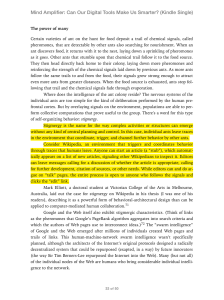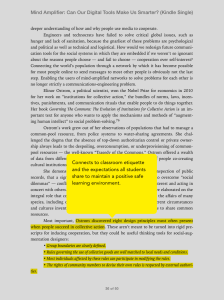As I concluded Howard Rheingold’s Mind Amplifier: Can Our Digital Tools Make Us Smarter? there were a few specific concepts worth questioning that stood out to me as an educator in a digital age.
The first is the concept Rheingold discusses in his chapter, “The Power of Many” (see image 1). Rheingold (2012) introduces stimergy: when complex activities or structures emerge without any planned efforts. He uses ant colonies as an analogy comparing the complexity of wikipedia. When ants find a food source, they leave trails of pheromones so that other ants can follow along on the same path; this path becomes easier to find the more ants that travel down it. Compare this example to wikipedia, where users lead each other to sources of information; the path becoming more developed and complex the more people contribute to it. Analyzing the stimergy taking place on the Internet, where the power of many contribute to digital content, concerns me as an educator. While this power could be exercised in a great way if the collective efforts are appropriately maintained, this power could also be misused. My concern with collective power present in our digital age is that it makes it more challenging for students to find and evaluate reliable information.
(Image 1)
Rheingold (2012) speaks to some of these concerns when he presents Ostrom’s eight principles for collective action (see image 2). Ostrom suggests clear defined boundaries for groups in order to collaborate efficiently.
(Image 2)
My eText experience this week went fairly smooth. I continued to use iBooks to read my text so that I could easily keep track of my page numbers rather than “location” on Kindle. I continued to use highlighting and notes to capture the ideas that I wanted to explore in my reflection. One amateur but valid observation I made this week in regards to reading a digital text pertains to my iPad and its battery life. My iPad, the device I have chosen to read my texts on, seems to have a fairly short battery life if you keep the device on when not using it. This created an issue for me several times throughout the week since I set aside time to read but my device was dead. Since I don’t have a hard copy of the text, this creates a obstacle. My experience translates to potential classroom situations. Does relying on technology as a means of delivering content provide students with an excuse to not complete assigned reading? In my experiences, my high school students have found creative ways to request for more time to complete an assignment, and a fear of mine is that digital texts may serve as a justified excuse. Are actual books the most reliable form of media for students? How can we rely on technology and specifically digital texts?


